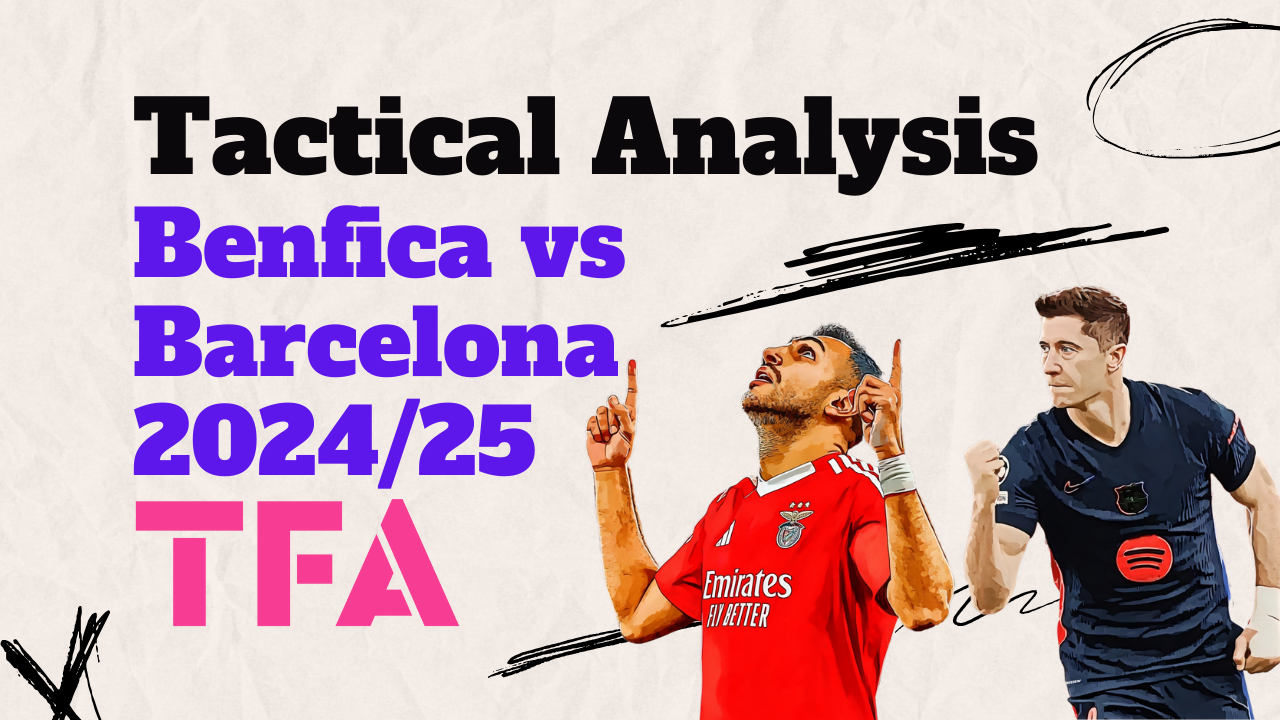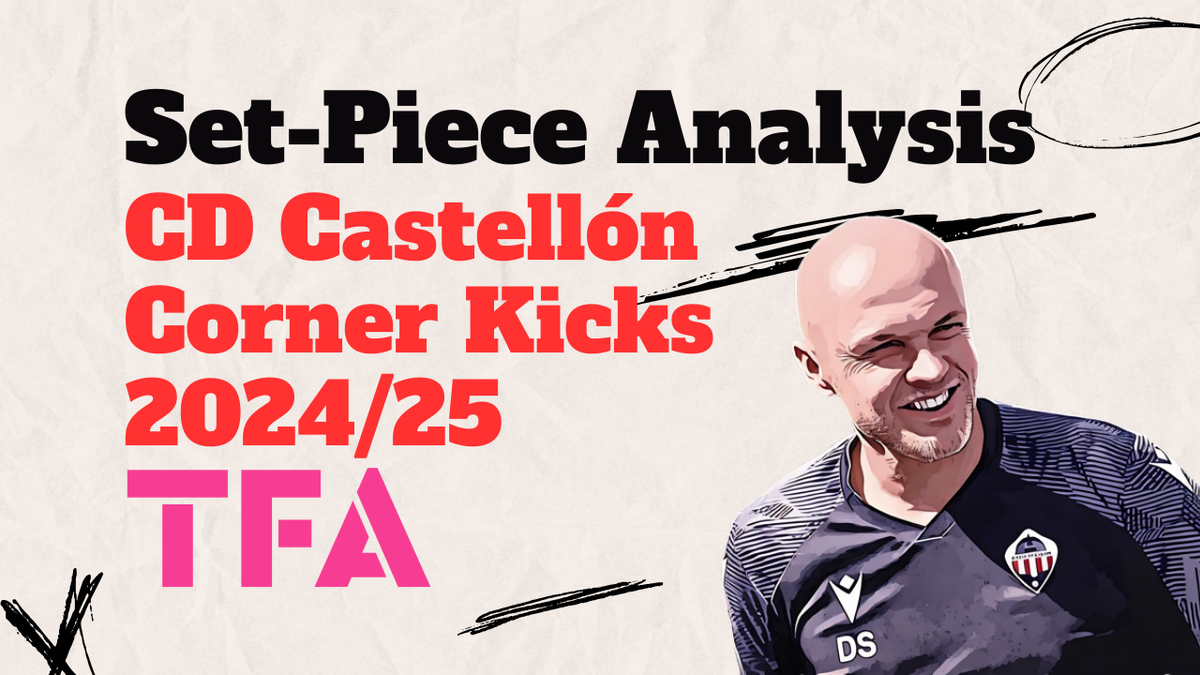There is considerable agreement among football fans worldwide that the Estadio de Luz may have just hosted one of the UEFA Champions League’s most exciting matches.
On a historical night in Lisbon, we saw an incredibly entertaining match between Benfica and Barcelona, creating new history with the first-ever 5-4 scoreline since the inception of the Champions League.
A match filled with calamitous errors and attacking flair was eventually capped off by Barcelona’s new-found saviour, with Raphinha guiding the ball past Anatoliy Trubin deep into stoppage time to claim all three points.
But despite the chaos, we were able to identify key tactical elements that were crucial for both teams' attacking success (and defensive weaknesses) on the night.
Hansi Flick’s unwavering determination to instil his tactics and principles in his new Barcelona squad appeared to limit their control in the first half, creating moments of weakness which Bruno Lage’s Benfica could exploit.
However, as with Barcelona’s successes so far in this campaign, the German coach’s genius always seems to prevail.
Our tactical analysis will begin by delving into some of the key tactical moments that influenced the match, including crucial tweaks in the second half that dramatically changed the outcome.
Benfica Vs Barcelona: Starting Lineups & Formations
In an attempt to qualify for the playoff rounds of the competition, Benfica were desperate for the points necessary to avoid the dreaded zone of no return.
They started with Anatoliy Trubin in goal behind a defensive line of Álvaro Carreras, Nicolás Otamendi, António Silva and Tomás Araújo.
Their midfield line of Fredrik Aursnes, Florentino Luís and Orkun Kökçü offered an exciting blend of roles and talents which looked to nullify Barcelona’s own strengths through the middle of the park.
Benfica’s attack was capped off with Muhammed Kerem Aktürkoğlu and Andreas Schjelderup offering a presence on the wings, with a striker in Vangelis Pavlidis who certainly knows how to find the back of the net on big occasions.
For Barcelona, a major talking point surrounded the selection of Wojciech Szczesny in goal for the Blaugrana, especially considering the benefit that Iñaki Peña would bring with his sweeping talents in behind a high defensive line.
Despite operating in varied roles and zones while in possession, Barcelona’s backline consisted of Jules Koundé, Ronald Araújo, Pau Cubarsí, and Alejandro Balde.
The supremely talented midfield trio of Marc Casado, Pedri and Gavi lined up as an outstanding advert for Barcelona’s youth program.
Raphinha and Lamine Yamal lined up on either wing for the away side.
These two players are quickly developing their ‘world-class’ tagline with outstanding performances this season.
They are two fantastic options to supply Robert Lewandowski, who is leading the line.
The Koundé Conundrum
Jules Koundé is quickly becoming one of the most talented right-backs in world football, but his attacking desire was evident from the start that it was hurting Barcelona’s rest defence and out-of-possession structure.
It coincides with a clear attacking threat from left-back Alejandro Balde from the left flank, usually leaving just the two central defenders within the defensive line for Barcelona.

While this is often remedied by a defensive-minded midfielder dropping between the two centre-backs to offer support, Flick’s team selection was perhaps missing that true ball-winner who could break up play.
From the opening minutes, it became evident that Barcelona’s defensive weakness would be related to these pockets of space that appeared out wide, especially when the Barcelona defensive line shifted heavily across the pitch.

Benfica consistently used long switches of play to target space in the final third.
However, Koundé was unable to effectively cut out Alvaro Carreras's run due to Andreas Schjelderup's presence on the interior.

As the move continued, Carreras was able to find the space and time to cross into the penalty area before Koundé could effectively close down the Spaniard, with Pavlidis taking advantage of Barcelona’s inability to shift across quickly and getting the best of Cubarsí through the centre.

Coupled with their desire to play an incredibly high defensive line, Barcelona almost found themselves two goals down within the first 5 minutes.
The present example once again shows Koundé’s positioning having a detrimental effect on the Barcelona out-of-possession structure.
This time, they look to overlap the creative Lamine Yamal to affect play within the final third.

But the first half of the match highlighted Carreras’ proficiency in both offensive and defensive situations, as the left-back picked Yamal’s pockets before launching a dangerous counter-attack for the home side.
Araujo was unable to fully commit to a wider defensive position due to the threat of Cubarsí being potentially isolated through the centre, allowing Benfica to counter with numerical superiority and once again launch a dangerous cross into the Barcelona box.

It poses a serious question for Flick and Barcelona going forward, as we know how effective Koundé can be for both club and country when attacking space in the final third.
But it was clear that Bruno Lage’s side would consistently look to work the ball across to the left flank to connect with the double-pronged attack, with multiple 2v1 scenarios occurring due to Yamal's lack of defensive commitment.
Benfica’s Defensive Solidity
Benfica’s defensive strengths were apparent throughout the opening stages of the match, with Barcelona limited in their shots outside of a few off-target attempts and those that failed to scare Trubin between the sticks.
Bruno Lage’s side looked to press in a 4-4-2 formation during the early stages of Barcelona's build-up play, quickly recognising that Cubarsí, in particular, has been an influential element of Barcelona’s progressive play under Hansi Flick.
With this in mind, Aursnes would look to jump out and support Pavlidis whilst the Benfica midfield settled into a structured line that was ready to react and deny time and space once passes, which had broken through the initial forward line.
Barcelona adopted a more 4-3-3 formation in the present example.
This formation seemed to lack creativity and became all too predictable, causing the hosts to close down due to the limited passing lanes.
Florentino acted as that calming presence when he had the bal, but could also instinctively cut out progressive passes when Barcelona looked to build play through the central zones.

These opportunities reminded Barcelona that Benfica wouldn’t just sit deep and defend their advantage.
The home side was able to quickly work the ball forward and target zones that the Barcelona defenders had vacated when anticipating their own attacking sequences.

On the contrary, Barcelona allowed the home side to have too much space in their defensive third by deploying a much weaker initial press.
This eventually resulted in Benfica unlocking Flick's high line, forcing Szczesny to rush out and try to connect with Otamendi's raking pass in behind.

We’ve come to understand this season that Barcelona have been proficient in beating the opposition’s press, and the away team were able to move the ball effectively between the thirds thanks to the ball-carrying talents of Balde and the technical quality of their midfield trio.
However, Barcelona lacked the creative spark that they needed within the final third, with Pedri’s creative tendencies slightly wasted in a deeper role alongside Marc Casado.
Barcelona’s usual rapid passing sequences and inventive combinations in and around the edge of the box were neutralised thanks to the eagerness of Benfica’s interior defenders, with the likes of Otamendi quick to jump out and pressure Lewandowski into some errant touches.

As we have already mentioned with Barcelona, the movement of Carreras up and down the left flank also raised some alarm bells when Yamal would be afforded time to operate in isolation.
But crucially for Benfica, the decision for both Schjelderup and Akturkoglu to drop deep when out of possession allowed them to consistently double up on the Barcelona wingers and protect the wider areas of their defensive block.
The Barcelona Breakthrough
Outside of a truly unthinkable goal in which Trubin’s launched ball deflected off the back of Raphinha’s head, Barcelona seemed to really struggle against the conservative and counter-attacking style of Benfica in the second half.
As the half went on, Benfica altered their defensive structure to become more of a 5-4-1 shape.
Its intentions were set on frustrating its opponents as Barcelona persisted with its attacking pressure.
The key switch for Flick’s team came just after the hour mark, with the German coach opting for the introduction of Frenkie de Jong and Fermín.
It completely revolutionised Barcelona’s midfield, with de Jong operating as more of a midfield orchestrator who could express his progressive tendencies from a deeper role, which freed Pedri to affect play between the lines as a more advanced eight.
Fermín shifted to the left wing, and his wider position became crucial in attempting to stretch the width of the Benfica block.
This allowed Raphinha to play as more of a right-sided attacking midfielder and operate closer to Yamal, targeting Carreras more intensely.
This only boosted Barcelona’s confidence when attempting to break into the final third.
Their width was almost used as a decoy to create more passing lanes through the middle of the pitch, reinforcing Flick’s preference for central progression.
Ferran’s introduction as another roaming inside forward only compounded this threat further, with Pedri able to target another striking presence with his line-breaking passes.

The numerical advantage in this crucial zone supported the quick ball movements that Barcelona had previously been lacking.
Yamal was able to receive in behind with the Benfica defence constantly pressurised to remain in compact shape.
Considering Barcelona’s ability to unsettle the Benfica defence, Flick's changes were imperative.
The relentless pressure finally reached the breaking point, allowing the away team to snatch all three points with an amazing comeback late on.

Conclusion
The first 5-4 in Champions League history had its intense moments, contentious decisions and a whirlwind of emotions.
While it may not have contained the jeopardy associated with some of the most famous European nights, the clash in Lisbon produced another glowing reason why the new UCL format should be here to stay.
Flick’s side didn’t have it easy but overcame their deficiencies with some inventive tactical tweaks and the introduction of some true game-changers across the pitch.
Things look a bit break for Benfica, potentially ruining their forgone lead, which seemed all too comfortable at times.
Nevertheless, it is clear that Bruno Lage’s side possesses the talent and determination to battle with Europe’s best, with a huge clash against Juventus on the horizon.





Comments